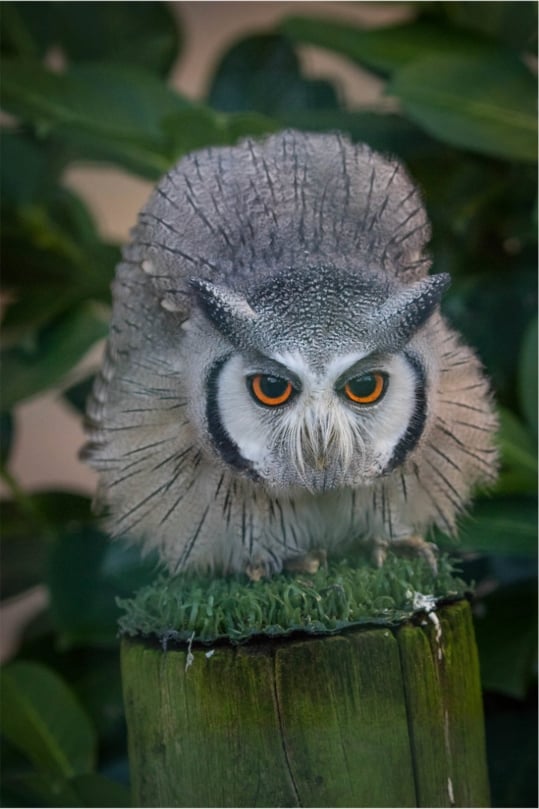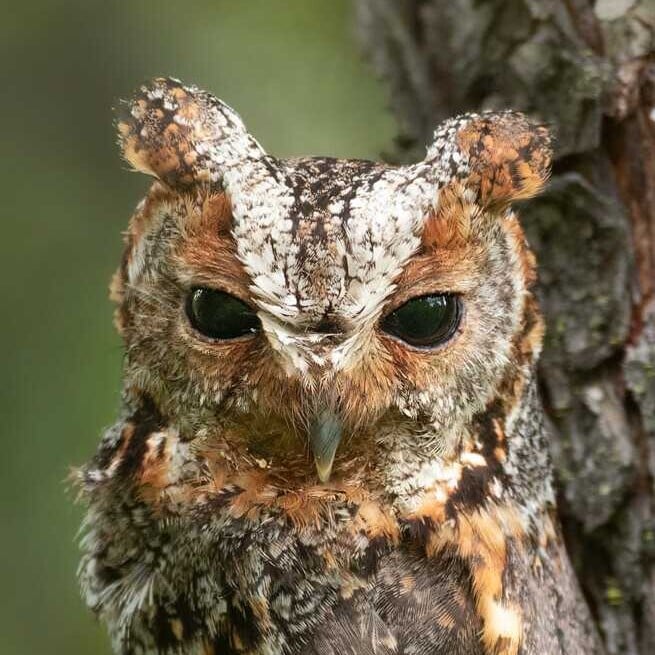There was an owl hooting outside our house earlier, and it occurred to me that every other bird has a high-pitched call.
Ravens have a croak that could be considered low, but their loud call is a caw that’s higher. I can’t think of another bird with a call nearly as low as owls’.
Search engines are no help, mostly duplicates answering why they hoot. Why are owls’ calls so much lower than other birds?
Got a unexpected lull in my morning workload and was able to find some really good info. I think these should be relatively digestible articles, they use some big fancy words, but I feel they break it down well enough for most to get the jist of things. Having some basic physics or music theory knowledge will help with really grok what they’re saying though.
This could be a decent writeup after in down the Owl of the Year if you guys want something a little more collected and simplified, but I’ll give you full links and highlights, and if there’s anything that isn’t making sense, we can of course take a look at it together, just give the word.
Brittanica - Signal Production
animals using sound communication because it is physically difficult for an animal to produce a loud sound with a wavelength much larger than itself. For this reason, small animals tend to communicate with high-frequency sounds, and only large animals use low-frequency sound signals. Aquatic animals require higher-frequency signals than do similarly sized terrestrial animals.
Think when someone shrinks or grows in a cartoon and their voice changes.
Varying the rhythm of insect stridulation or bird breathing is one way to produce different signals. Air-breathing vertebrates can also change the tension on the vibrating membranes to produce quite complicated frequency modulations. A third mechanism is to produce sounds that initially contain many different frequencies and then selectively filter out some frequencies and amplify others.
Many neat musical comparisons here! Timbre, additive and subtractive synthesis, etc!
All animal signals degrade as they propagate between sender and receiver. The farther apart the two parties, the greater this degradation will be and the less a signal will stand out from background noise. Senders can do little to reduce degradation once the signals have left the sender. However, they do have a choice of what kind of signal they produce, and evolution has often favoured choices that minimize degradation.
Sound signals transmit efficiently over large distances, around obstacles such as trees and foliage, and in dark environments. Nevertheless, sounds of all frequencies become less intense as they radiate away from a source. Higher frequencies suffer additional attenuation owing to heat losses and scattering of the sounds. Since small animals can produce only high frequencies (short wavelengths), their sound communication is often limited to short distances. Furthermore, ambient sound is often greatest at low and high frequencies, making intermediate frequencies the ones least likely to be obscured by the background.
Bandwidth issues as I referenced earlier…
Birds, even of the same species, are much more likely to use rapid temporal modulations of their calls, such as trills and buzzes, when they live in grasslands than when they live in forests. Forest birds typically produce long whistlelike notes with slow, if any, modulations.
Environment helps determine what sounds an animal will make to communicate effectively.
Detection of sound is often challenging because the received signals are faint and distorted owing to propagation. Sound traveling in air is largely reflected from solid objects, including animals, with little energy transfer. Sound traveling in water is easily transferred to aquatic animals, but because all parts of the animal vibrate in synchrony, there is no immobile reference allowing the animal to detect the vibrations. As a result, animals have had to acquire some very sophisticated adaptations to hear sounds.
More bandwidth issues.
The rest of the article goes more in depth and also covers visual and olfactory communication. Tons of great stuff in here! I’m definitely going back to read this again when I have more time.
Science Direct - Vocalization (Rest of article is paywalled)
Some birds may have anatomical or physiological limits in their ability to vocalize at higher frequency ranges to be heard over traffic noise. This could include the angle they can hold their head, how wide they can open their beak, their beak shape, and their body size. Typically, the frequencies that birds are able to produce are related to their body size. The larger the body size, the lower the frequency of the bird’s songs or call; and, the smaller the body size, the higher the frequency of their vocalizations (Ryan and Brenowitz, 1985). There is also an association between body size and amplitude (Brumm, 2004). The larger the body is, the greater the amplitude and vice versa. A bird cannot change the vocal mechanisms in their throats that allow for certain characteristics of a song to be produced
Anatomy is a key player in the amounts and types of noises animals can make.
Ugh, hitting too many paywalled articles. Let me know if this is good for an answer or if you need more. I’ll definitely be reading more about this in my own, but I did get Jennifer Ackerman’s What an Owl Knows book to read also to see what is in there. I’ve put up some interviews with her on here before and I’ve always found them interesting, so I’m trying to get that bumped up in my to do list. This is a very interesting topic though, so if you do want more clarification on anything, just let me know!
What a beautiful infodump, thank you!
My pleasure!
This is a lot of information to absorb; thank you for all the work in writing up a great summary!
I thought size wasn’t a factor, considering eagles’ high-pitched calls, and most interesting to me was the first quote:
it is physically difficult for an animal to produce a loud sound with a wavelength much larger than itself.
This is blindingly obvious… in retrospect. When I read it, I thought of musical instruments - a piccolo vs an oboe - but it was really interesting.
I thank you for bringing it up, I hadn’t thought to read much about it before!
I still have some things bookmarked to read about it, but what I found to share with you was really interesting!
Lower frequencies travel better through dense areas I think. So birds in dense woods would be lower pitched. This is a massive and probably incorrect guess.
I’ll agree with you here. My knowledge comes from choir teachers telling the boys to shut up because our voices boom through the walls.
This is a great question! I haven’t done much with vocalization here yet, due to I still think it’s kinda janky and uneven of an experience how Lemmy deals with video clips.
I feel the others who have commented do far are on the right track. I recall reading recently something about how animals do something along the lines of how we divide bandwidth of communication spectrums up for different uses, emergency bands, TV signals, phones, radio, etc. Basically if everyone was talking in the same frequency range, there would be distortion.
I’ll see what I can find article-wise for you. Also, if you let me know your general area (Southwest US, England, east Australia, whatever) I can try to get together so different owl sounds you may be hearing add don’t even know they’re owls. Some are very unexpected!
Thanks!
Minneapolis, MN, USA, and it was most active around 2am.
However, it sounded to me the same as the owls we’d hear in Eastern PA, and in Bend, OR. It’s what I’ve come to think owls just sound like: a low “hoo, hoo, hoo-hoo!”
I want to get you a more in depth answer on your actual question, but I’ll have to do that later today. In the meanwhile, this is a quick guide to MNs owl sounds.
Your particular owl I’m betting is a Great Horned Owl. That’s the one I’ve got in my neighborhood in southeast PA. I figured out it was him but googling “Pennsylvania owl that hoots 5 times” and that sounds like exactly what you have. It also seems to be the most common owl in MN, and since GHO has no predators, they get to be more vocal than many smaller owls.
My wife has an app for recording and identifying birds. Like Shazam for birds. Sadly, she’s smart enough to not be awake at 2am.
I’mn not sure about the typical hoot but apparently owls make many different sounds including higher pitched ones.
I think everybody here’s right.
However, that still doesn’t answer the question of how they are so low…
I believe that would require that their “voicebox” be huge, compared with other birds’.
Every bit as much a guess as the others, here,
but a knowledge-based guess, as the others are, too.
Insightful question!
_ /\ _
The syrinx is a birds equivalent of our vocal chords.
Unlike the larynx in mammals, the syrinx is located where the trachea forks into the lungs. Thus, lateralization is possible, with muscles on the left and right branch modulating vibrations independently so that some songbirds can produce more than one sound at a time.[3] Some species of birds, such as New World vultures, lack a syrinx and communicate through throaty hisses. Birds do have a larynx, but unlike in mammals, it does not vocalize.
Addendum from PA Game Commission
The great horned is known as the “hoot owl” for its call, three to eight (usually five) deep, booming, uninflected hoots: hoo-hoohoo hoo, given in a pattern somewhat like a Morse code message and has great carrying power. The hoot of the larger female is higher pitched than that of the male due to her smaller syrinx.
Hoo knows







